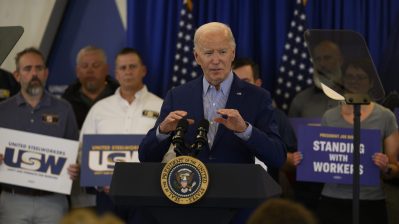Getting college students across the finish line
Saturday is graduation day at Georgia State University. And more than half the students who came in as freshmen will walk the stage for their diplomas.
A decade ago, that number would have been about one student out of three.
Here’s the thing about graduation rates. The calculation starts the second a student steps foot in class. And it doesn’t matter if that student drops out on day one, or one day before graduation.
When you’re talking numbers, it’s all the same.
“I am the definition of a non-traditional student, from age to being a mother,” says Lucille McGee, a GSU student who was on the fast-track to becoming a drop-out statistic
Two years ago, Lucille moved from New Jersey to Atlanta to attend Georgia State.
She was 24, the first in her family to go to college, and she had a new baby. But when she showed up on campus, the tuition money she thought would be there wasn’t. Lucille was about $3,000 short with no way to pay.
“I am older, so maybe I’ll just have to go back to work and save my money,” she told herself.
But, really, Lucille knew better.
“I knew in the back of my mind I wouldn’t be returning,” she says.
Georgia State saw this pattern over and over: bright, capable students walking away because they just didn’t have the money.
“A number of the students we were dropping were short by $300, by $400,” says Tim Renick, Vice Provost and Chief Enrollment Officer at Georgia State.
“When I sometimes present this account to outside audiences, they say ‘Well, why didn’t they go to their parents to get the money, why didn’t they get a loan from a bank to get that money or some other kind of loan,’” he says. “And the reality is a lot of these students are maxed out.”
So a few years ago, the university instituted what’s called a bridge grant.
The administration flagged students who were automatically dropped for non-payment. Those who owed the least got their grants first, and it went on down the line until the pot ran out.
Georgia State University president Mark Becker provided the initial seed money out of his own pocket — about $40,000.
“Higher education was transformational in my life,” says Becker. “I was a first-generation college student, and saw the life I was able to live because of a college education.”
The bridge fund is now worth a couple million dollars.
But it’s just one way the school keeps students on track to graduate from the minute they arrive on campus.
Another is data.
GSU found that students often get derailed because they take classes that don’t count toward graduation. With 32,000 students, it’s not like staffers can check every registration.
But a computer can.
Now the school “flags” students if they’re headed for trouble.
“I think it’s definitely a notable increase,” says the Brooking Institution’s Matthew Chingos of GSU’s progress.
Chingos says colleges often pour tons of money into improving graduation percentages.
“Colleges spend money on lots of different things — on research, on teaching, on student support,” he says.
Chingos adds more money isn’t necessarily better.
“And in general, there isn’t that much of a correlation once you take into account student characteristics,” he says.
In other words, things like SAT scores and socioeconomic status play a bigger role in getting students across the finish line than the amount of cash a school throws at the problem.
But studies show a little help can go a long way in creating success stories like Lucille McGee’s.
“I plan to go to medical school upon graduation,” she says, adding that she has just two semesters to go.
As far as Saturday’s graduation, Georgia State will hand out a record 4,000 diplomas. That includes to some 300 to students who might not have made it a decade ago.
There’s a lot happening in the world. Through it all, Marketplace is here for you.
You rely on Marketplace to break down the world’s events and tell you how it affects you in a fact-based, approachable way. We rely on your financial support to keep making that possible.
Your donation today powers the independent journalism that you rely on. For just $5/month, you can help sustain Marketplace so we can keep reporting on the things that matter to you.


















